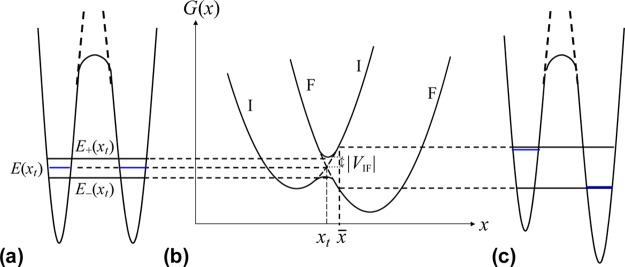Figure 19.

(a) Effective potential energy V(xt,q) (q is the reactive electron coordinate) for the electronic motion at the transition-state coordinate xt. x is a reaction coordinate that depends on R and Q. The energy levels corresponding to the initial and final electron localizations are degenerate at xt (see blue bars in the figure). Denoting the diabatic electronic states by |ϕI,F(x)⟩, which depend parametrically on x, E(xt) = EI(xt) = ⟨ϕI(xt)|V(xt,q) + T̂q|ϕI(xt)⟩ = EF(xt). However, such levels are split by the tunnel effect, so that the resulting adiabatic energies are E± and the corresponding wave functions are equally spread over the electron donor and acceptor. (b) The effective potential (free) energy profile for the motion of the nuclear coordinate x is illustrated as in Figure 16. (c) An asymmetric effective potential energy V(x̅,q) for the electron motion at a nuclear coordinate x̅ ≠ xt with accordingly asymmetric electronic levels is shown. The additional splitting of such levels induced by the tunnel effect is negligible (note that the electronic coupling is magnified in panel b). The black bars do not correspond to orbitals equally diffuse on the ET sites.
